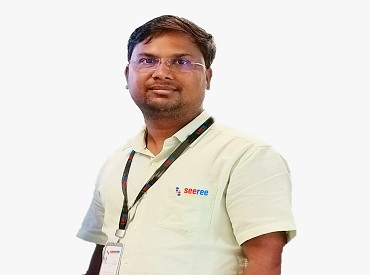Best Python Course in Bhubaneswar
Why Best python course in Bhubaneswar at seeree
Seeree offers best python course in Bhubaneswar with 100% job assurance and low fee. Learn from real time corporate trainers and experienced faculties. Groom your personality with our faculty. Seeree helps to build confidence in students to give exposure to their skills to the company.
why seeree No.1 institute
- Learn from Corporate Trainer
- Logic Development Class Every Sunday Free
- How to create your resume
- How to maintain your linkedIn / Indeed / naukri
- Update your GIT Repo - By Er. Nagarjun
- Providing Course wise Assessment only at SEEREE
- How to represent yourself in interview - By Er. SwatiSrinivas
- Doubt Clear classes anytime everyday
- 100% job assurance
- Experienced Career Consultant - ER. Prabin K Rout / Er. Sritam / Er. Bishnu
- Corporate Syllabus
- Incomparable Syllabus
- Learn from MICROSOFT Certified Professional
- Learn secret step for Campus requirement
- Real Industrial Application of using MVC
- Fully Practical and Interactive Session
- Grooming for Project Demonstration in Campus Interview
- Weekly Workshop on Respective module for Skill Development
- Special Guidance for LIVE Project
- Weekly Online Test for Skill Assessment
- An Earning and Learning Opportunity to all.
- SEO Tips, Study Materials
- Industrial Training from the Leader
- Interview based Q & A discussion
- Free Career consultation
Trainer Profile


Introduction to PYTHON
Python is dynamically typed , compiled and interpreted , procedural and object oriented , generalized , general-purpose , platform independent programming language. Python is a high-level, structured, open-source programming language that can be used for a wide variety of programming tasks.
Dynamically type : before using any variable , if it isn’t required to declare the type of variable , then it is called dynamically typed programming language .
age=20 # int name="raja babu" # str width=10.4 # floatNote: python is dynamically type PL.
General Purpose PL : if the programming language is used for various purpose type of applications . it is called general purpose programming language .
Python for GUI Application (using tkinter)
Python for Web Application (using django)
Python for Mobile Application (using KiVy)
Python for Embeded Application , DL , ML
etc.
Example of GUI :
from tkinter import * obj=Tk()Note : python is a general purpose PL
Core Python
1.Introduction to Python
2.Operators
3.Data Types
4.Memory Management
5.Control Structure & Control Statement
6.Function
7.Module & Package
8.File Handling
9. Command Line Argument
10.Exception Handling
Object Oriented Programing Structure
11.Class & Object
12.Data Member
13.Member Function / Method
14.Constructor, Destructor & Garbage Collector
15.Operator Overloading
16.Type Conversion
17.Relation
18.Inheritance
19.Polymorphism
20.Abstract Method & Abstract Class
Advance Python
21.Process
22.Signals
23.Multi-Threading
24.Network Programming
25.Databases Programming
26.Graphical User Interface
27.Data visualization
28.Numpy
29.Pandas
30.Django
Introduction to UI & UX
UI refers to the screens, buttons, toggles, icons, and other visual elements that you interact with when using a website, app, or electronic device. UX refers to the entire interaction you have with a product, including how you feel about the interaction.
1. INTRODUCTION
2. Installation and configuring
3.HTML
4.Style Sheet / CSS
5.JavaScript
6. JQuery
7. Ajax
8.JSON
9. REGULAR EXPRESSION
10.Bootstrap
11.FIGMA / PHOTOSHOP
Introduction to Database
A database is simply a structured and systematic way of storing information to be accessed, analyzed, transformed, updated and moved (to other databases).
- Types of Data Base Management Soft and Classification
- Codd's Rule (Golden Rule of Database)
- Pure and significand Difference among DBMS, RDBMS, ORDBMS
- What is Table ?
- What is a Record ?
- What is Field ?
- Super Key
- Candidate Key
- Primary Key
- Composite Key
- Secondary or Alternative key
- Non-key Attribute
- Non-prime Attribute
- Normalization
- Problem Without Normalization
- Normalization Rule
- First Normal Form (1NF)
- Second Normal Form (2NF)
- Third Normal Form (3NF)
- Byte and Code Normal Form (BCNF)
- Relationship
- Binary Relationship
- Recursive Relationship
- Ternary Relationship
- Generalization
- Specialization
- Aggregation
- Introduction to SQL
- DDL : Data Definition Language
- DML : Data Manipulation Language
- TCL : Transaction Control Language
- DCL : Data Control Language
- DQL : Data Query Language
- Creating a Database
- Creating a Table
- Datatype and Magnitude
- Data Type and Magnitude with context to Performance of the Database
- Sub Query and Co Related Sub Queries
- WHERE clause
- Operators (Relational(<,<=,>,>=,=,!=), Logical (And, Or, Not), Like, Between, in ,
- Some, Any ,All
- Order By Clause
- Group By Clause
- HAVING Clause
- Distinct keyword
- Concept of NULL
- SQL Functions
- System Define Procedure / Functions
- Join in SQL (Difference between Pro SQL 99 and SQL 99 Standard)
- Inner Join
- Outer Join
- Left Join
- Right Join
- Full Outer Join
- Self-Join
- Cross Apply
- Outer Apply
- SQL Alias
- SQL View & Common Table Expression
- Materialized View and its Use, with context to views, Different types of View i.e. Classification
- SQL Functions and Procedure and there primary difference , Where what to be imposed
- Exception Handling
- INDEX
- TRIGGER
Introduction to Django
Django is a free and open-source, Python-based web framework that follows the model–template–views (MTV) architectural pattern. Its primary goal is to ease the creation of complex, database-driven websites.
Django FrameWork
- Introduction & installation
- App and project
- Add templates & static
- jinja.
- Migration in detail.
- Admin in Django
- Views in Django.
- URL Routing.
- Template in Django
- Models in Django.
- Forms in Django.
- Auth
- Session and cookie
- File uploading
- File downloading
- SMS and Mail
- Middleware
- cron job
- pdf generator
- face recognition
API
- API in python
- REST methods
- Json calling
- Pytest
